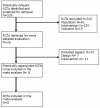Cost-effectiveness of collaborative care for the treatment of major depressive disorder in primary care. A systematic review
- PMID: 20082727
- PMCID: PMC2826303
- DOI: 10.1186/1472-6963-10-19
Cost-effectiveness of collaborative care for the treatment of major depressive disorder in primary care. A systematic review
Abstract
Background: The effectiveness of collaborative care for patients with major depressive disorder in primary care has been established. Assessing its cost-effectiveness is important for deciding on implementation. This review therefore evaluates the cost-effectiveness of collaborative care for major depressive disorder in primary care.
Methods: A systematic search on economic evaluations of collaborative care was conducted in Pubmed and PsychInfo. Quality of the studies was measured with the Cochrane checklist and the CHEC-list for economic evaluations. Cost-effectiveness and costs per depression-free days were reported.
Results: 8 studies were found, involving 4868 patients. The quality of the cost effectiveness studies, according to the CHEC-list, could be improved. Generally, the studies did not include all relevant costs and did not perform sensitivity analysis. Only 4 out of 8 studies reported cost per QALY, 6 out of 8 reported costs per depression-free days. The highest costs per QALY reported were $49,500, the highest costs per depression-free day were $24.
Conclusions: Although studies did not fulfil all criteria of the CHEC-list, collaborative care is a promising intervention and it may be cost-effective. However, to conclude on the cost-effectiveness, depression research should follow economic guidelines to improve the quality of the economic evaluations.
Figures
Similar articles
-
Home treatment for mental health problems: a systematic review.Health Technol Assess. 2001;5(15):1-139. doi: 10.3310/hta5150. Health Technol Assess. 2001. PMID: 11532236
-
The clinical effectiveness and cost-effectiveness of low-intensity psychological interventions for the secondary prevention of relapse after depression: a systematic review.Health Technol Assess. 2012 May;16(28):1-130. doi: 10.3310/hta16280. Health Technol Assess. 2012. PMID: 22642789 Free PMC article.
-
The clinical effectiveness and cost-effectiveness of enzyme replacement therapy for Gaucher's disease: a systematic review.Health Technol Assess. 2006 Jul;10(24):iii-iv, ix-136. doi: 10.3310/hta10240. Health Technol Assess. 2006. PMID: 16796930
-
Topotecan, pegylated liposomal doxorubicin hydrochloride and paclitaxel for second-line or subsequent treatment of advanced ovarian cancer: a systematic review and economic evaluation.Health Technol Assess. 2006 Mar;10(9):1-132. iii-iv. doi: 10.3310/hta10090. Health Technol Assess. 2006. PMID: 16545208
-
A rapid and systematic review of the clinical effectiveness and cost-effectiveness of topotecan for ovarian cancer.Health Technol Assess. 2001;5(28):1-110. doi: 10.3310/hta5280. Health Technol Assess. 2001. PMID: 11701100
Cited by
-
Collaborative mental health care program versus a general practitioner program and usual care for treatment of patients with mental or neurological disorders in Germany: protocol of a multiperspective evaluation study.BMC Psychiatry. 2018 Oct 25;18(1):347. doi: 10.1186/s12888-018-1914-5. BMC Psychiatry. 2018. PMID: 30359248 Free PMC article.
-
Economic evaluation of psychological treatments for common mental disorders in low- and middle-income countries: a systematic review.Health Policy Plan. 2023 Feb 13;38(2):239-260. doi: 10.1093/heapol/czac069. Health Policy Plan. 2023. PMID: 36005943 Free PMC article.
-
Interprofessional collaboration in primary care: what effect on patient health? A systematic literature review.BMC Prim Care. 2023 Nov 29;24(1):253. doi: 10.1186/s12875-023-02189-0. BMC Prim Care. 2023. PMID: 38031014 Free PMC article.
-
Effectiveness of a coordinated ambulatory care program for patients with mental disorders or multiple sclerosis: results of a prospective non-randomized controlled trial in South Germany.Front Psychiatry. 2023 Dec 19;14:1183710. doi: 10.3389/fpsyt.2023.1183710. eCollection 2023. Front Psychiatry. 2023. PMID: 38179252 Free PMC article.
-
Collaborative treatment of late-life depression in primary care (GermanIMPACT): study protocol of a cluster-randomized controlled trial.Trials. 2014 Sep 6;15:351. doi: 10.1186/1745-6215-15-351. Trials. 2014. PMID: 25195020 Free PMC article. Clinical Trial.
References
Publication types
MeSH terms
LinkOut - more resources
Full Text Sources



